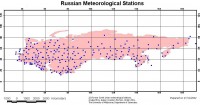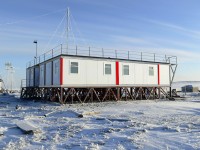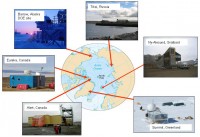By Anthony Watts, Watts Up With That
As most readers know by now, the problematic GISTEMP global temperature anomaly plot for October is heavily weighted by temperatures from weather stations in Russia. Like in the USA, weather stations tend to be distributed according to population density, with the more populated western portion of Russia having more weather stations than the less populated eastern areas such as Siberia. To illustrate this, here is a plot of Russian Weather Station locations from the University of Melbourne:

Abrupt repeated changes don’t seem fully natural to me, particularly when they occur over the same geographic location twice. I realize that two events don’t make a trend, but it is curious, given that we now have had a problem with Russian weather data again that caused GISS to announce the “hottest October on record”.
I also noticed that in the animation from the anomaly maps, there does not seem to be much of an anomaly in the summer months.This made me wonder what some of those weather stations in Russia might be like. So I went to the Russian Meteorological Institute website.
I know from John Goetz work as well as this artcle in Nature that Russian weather stations had been closing with regularity due to the trickle down effects of collapse in the former Soviet Union. Though some new ones are being built by outside agencies, such as this one sponsored by NOAA in Tiksi, Russia.

What I found interesting in the NOAA press release on Tiksi, was this image, showing weather stations clustered around the Arctic:

See larger image here
The interesting thing is that all these stations are manned and heated. The instruments appear to be “on” the buildings themselves, though it is hard to tell. One wonders how much of the building heat in this tiny island of humanity makes it to the sensors. The need for a manned weather station in the Arctic always comes with a need for heat.
I was hoping my visit to the Russian Meteorological institute website might have some particulars on the remaining weather stations that have not been closed. I didn’t find that, but what I did find was a study they posted that seems to point to a significant warm temperature anomaly in Russia during winters between 1961 to 1998. From the Russian study they write:"For the winter period 1961-1998, most of the stations under considerations exhibit a tendency for fewer minimum temperature extremes.” Whenever I read about elevated minimum temperatures, I tend to suspect some sort of human influences such as UHI, station siting, or irrigation (humidity) which tend to affect Tmin more than Tmax. In Northern Russia Siberia, I wouldn’t expect much in the way of irrigation. So that leaves station siting and UHI as possible biases. UHI seemed doubtful, given that many of these Russian Stations in Siberia are in remote areas and small towns.
See how with further detective work, Anthony concluded the UHI like warming may be the result of siting issues and “district heating” where uninsulated hot water pipes carry hot water to residential and commercial users here. See also Steve McIntyre and his commenters take apart the GISS.GHCN, and Hadley global versions here. Hopefully with all this attention, we will begin to change the focus from the hopeless models to getting the data right.




